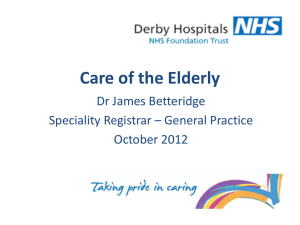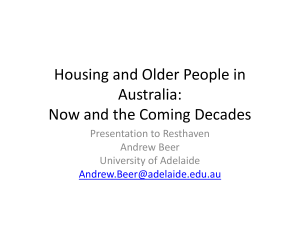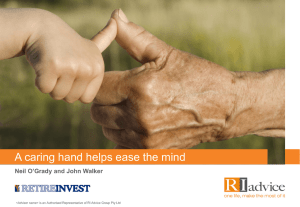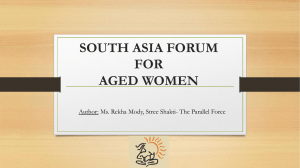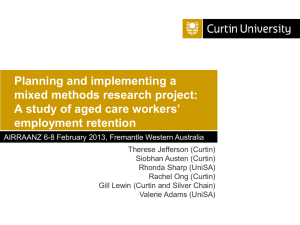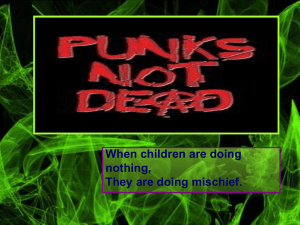THEORIES IN GERONTOLOGY
advertisement
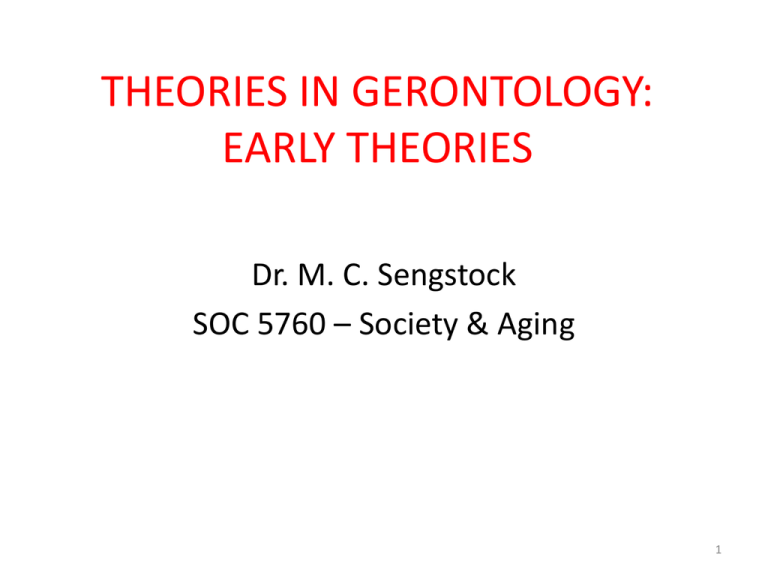
THEORIES IN GERONTOLOGY: EARLY THEORIES Dr. M. C. Sengstock SOC 5760 – Society & Aging 1 5 PHASES OF THEORY IN GERONTOLOGY 1. Pre 1960: Problems Approach; No Theories 2. 1960s: Early Theory: Disengagement – Activity – Subculture of Aging 3. 1970s: 2nd Generation Theories Age Stratification – Personality Continuity 4. 1980s & Later: Emergent Theories Focus on Contextual & Structural Arrangements 5. More Recent Theories: Greater Focus on Theories from Individual Disciplines 2 SOCIAL THEORIES OF AGING: WHAT IS THE PURPOSE OF THEORY? • • • • Organize What Is Known About a Topic Propose Explanations for Data Observed Suggest Hypotheses Predict Future Findings 3 EARLY THEORIES IN GERONTOLOGY • Focused On Role Theory (Applicable to Nearly Everything!) • ROLE: The Activities Required by Statuses (Social Positions) • COMPONENTS: Role Expectations (Norms), Role Socialization, Role Changes, Role Discontinuity (Esp. in Times of Transition) • Early Gerontology Theory Focused on the Way Roles Were Assigned & Developed • Also on the Way They Had to Change As People Reached Old Age 4 DISENGAGEMENT THEORY • Cummings & Henry, 1961 • Kansas City Study of 275 Persons 50-90 Yrs Old • NOTE: Discussion in Text (Hooyman & Kiyak) Is Rather Sterile • Disengagement Very Influential At That Time • Was the Basis of Much Social Policy • Focused Primarily On LOSS of ROLES As People Grew Old 5 TENETS OF DISENGAGEMENT • • • • • Old Age Is Period of Mutual Withdrawal Aged Withdraw From Society & Reverse From Work, Family, Friends, All Institutions MUTUAL Separation From PEOPLE & ROLES Society Pushes Them Out – Get Rid of Them & Make Room For Young • Aged WANT to Withdraw – They Know They Are Less Able & Face Imminent Death 6 DISENGAGEMENT (ctd) • NORMATIVE Withdrawal Accompanies & Follows Actual Withdrawal • As Elderly Become Separated From Society, They Are Less Controlled By It • They Follow Their Own Rules • They Become Even More Separated • This is What Is Meant By “DISENGAGED” • “Gerotranscendance Theory”: Old Focus More on Self-Development Than Rational, Economical View of the World 7 CONSEQUENCES OF DISENGAGEMENT • Poor Adjustment to Old Age May Occur • Due to LACK OF SYNCHRONIZATION Between Society’s & Individual’s Disengagement • One Side – Usually the Individual – Is Behind the Other in Withdrawing • Reengagement Occurs If New Skills Learned • Low Morale Occurs if Pattern Does Not “Fit” • Men’s Disengagement More Sudden: Work Roles Cease More Suddenly Than Women’s Home Roles - Remember: This is the ’60s – Women Didn’t Work 8 DISENGAGEMENT: RECOMMENDATIONS & CRITIQUE • Solution To Old Age Problems: Encourage Aged to Withdraw • CRITICISMS: Theory Suggests: • Withdrawal Is Inevitable • Withdrawal Is Functional for Both • Fails to Consider Individual Personal Factors of Aged Persons • All Elderly Do NOT Want To Withdraw – Nor Do Their Families & Friends Want Them To 9 CUMMINGS & HENRY’S RESPONSE • Distinguished Between Appearance & Reality • Old People Are Really Disengaged – Even If They Don’t Look Like It • Recognized Physical/Psychological Differences • “Impingers” (Activist, Assertive People) Disengage Slower Than “Selectors” (Passive) • Women Socialized to Change Roles Easier Than Men So They Adapt Better 10 CUMMINGS & HENRY RESPONSE (ctd) • Disengagement Is Part of “Increasing Interiority” – Emphasis on Self vs. Other • This Occurs Throughout Life • Some People Are More Disposed to Interiority (Introverts) • They Will Disengage Faster Than Extroverts • This Leads to a More “Developmental Psych” Approach – Moving Through Life Stages 11 ACTIVITY “PERSPECTIVE” • • • • • Havighurst & Albrecht, 1953; Maddox, 1970 Not Developed Enough For a Real Theory Also Focused on ROLE LOSS of Old Age Attempted to “Turn It Around” 4 Essential Postulates: – – – – Role Loss Is Related to Loss of Activity Role Support Is Related to Activity Stable Role Support Produces Stable Self Concept Positive Self Concept Produces Life Satisfaction 12 ACTIVITY PERSPECTIVE (ctd) • “Activities” Are Parts of Roles • Activities Increase Through Child & Adult Life • Individual’s Self Concept Receives Validation Through Successful Activity Performance • With Old Age – Activities Decrease • To Maintain High Morale New Activities Must Be Adopted 13 COMPARING THE THEORIES • DISENGAGEMENT THEORY: • Old Must Learn to GIVE UP Roles, Activities • ACTIVITIES THEORY: • Old Must Learn to DEVELOP New Roles, Activities 14 CONSEQUENCES OF ACTIVITY THEORY • Suggests Disengagement Occurs Only for the Very Old • For Most Older People, Increased Activity Is Necessary for High Morale • Suggested That “Activities” Should Be Created for Older People to Provide Them New Things to Do – & Lead to Higher Morale 15 CRITICISM OF ACTIVITY THEORY • Does Not Deal With Social Value of Activities • Will Any Old, Meaningless, Time-Consuming Activities Do? • Many “Activities” Were Meaningless (Nursing Homes Made Bread Wrapper Placemats) • May Have a Middle Class Bias: Assumes Everyone Must Always Do Something “Useful” • Importance of Leisure – Old People May Have a Right & Desire for Leisure! 16 SUBCULTURE OF AGING THEORY • Sociological Theory (A.Rose, 1965; J.Gubrium) • NOTE: “Subculture” Does NOT Refer to a Less Valuable Culture • It Refers to a Culture Practiced By A Smaller Segment Than the Population As a Whole • Sees Close Relationship Between: Roles – Social Identity – Self Concept 17 SUBCULTURE OF AGING (ctd) • A Distinctive AGED SUBCULTURE Develops: • Aged Interact More With Each Other Than Younger People • Demographic Changes Produced Many Old • Older People Are Targets of Discrimination • Older People Live Together in “Aged Ghettos” • Social Agencies Serving Elderly Promote It! • EX of Aged Subcultures: – FL Retirement Communities: Juvenile-Style Crime – Mesa, AZ Laws Against Children, Schools – 55 Yr Olds Aspiring to Retirement Community Living 18 PARTICIPATION IN AGED SUBCULTURE An Aged Person’s Participation in the “Aged Subculture” Is Dependent Upon: • Solidarity of the Age Group • Number of Aged Organizations, Their Strength • Number of Aged IN vs. NOT in Aged Groups – I.e., Who Associate More With Family, Friends – Are More Isolated From the Aged Community • SUM: Elderly In Retirement Communities – Part of Aged Subculture • Those in General Communities – Probably NOT 19 AGED SUBCULTURE: SUMMARY & CRITIQUE • SUM: There Will Be An Aged Subculture If Most Elderly Spend Most of Their Time With Old People & Little Time With Younger People (Family, Neighborhood, Church, Work) • QUESTIONS: Is There Really An Aged Subculture? • Does It Apply to All Aged? • Which Is Better: • Strong Aged Subculture? Or Weak One? 20 AGE STEROTYPING • • • • • Concept Related to Aged Subculture Theory Over-Simplified Generalizations About Aged Often Accepted By Young, Middle-Aged Often Accepted By Old As Well EX: Old-Fashioned; Fussy; Forgetful; Senile; Crotchety; Demanding; Asexual; Radically Different From Younger Persons; Men Upset By Retirement; Women By Children Leaving 21 CONSEQUENCES OF STEREOTYPES • Complaints By Elderly Are Often Dismissed As Results of Normal Aging or Examples of Old People Constantly Complaining • Are Stereotypes Accurate? For Whom? • Who Fares Best? • Wealthy: Comfortable: Age a Pleasant Surprise • Poor: Aging Is As Portrayed: Little Money, Poor Health, Left Out of Things 22 IMPACT OF METHODOLOGY • These Theories Probably Resulted From Methodological Patterns • Early Research Done on Institutionalized Aged • Easy to Access for Study Subjects • Different From Community Dwelling Aged … • Who Are NOT Separated From Community As a Whole • Who Interact a Lot With Younger People 23 AGE STRATIFICATION THEORY • A 2nd GENERATION THEORY • Shifted Attention from the Individual Roles Approach • Focused More on Broader Social Structure • Sociological Theory • Matilda White Riley, et al, 1972; Dowd, 1980 24 AGE STRATIFICATION THEORY (ctd) • • • • • • Structural Components: Same Variables As Any Stratification System: Socio-Economic Status (SES); Ethnic Minorities Age Strata: All Societies Have Age Subgroups Size & Composition Varies With the Society Each Stratum Differs in Terms of: – Physical, Psychological, Social Conditions • Results in Age-Related Capacities 25 AGE-RELATED ROLES • Roles Are Patterned/Distributed Based on Age – Directly: Women’s Age Determines Pregnancy – Indirectly: Rules Determine Entry Into School – Generally Roles Are Distributed By Age • Parents of Preschoolers; Retirees • Age-Related Expectations: – People of Different Ages Play Roles Differently – Partly Due to Physical Ability – Partly Due to Experience, Knowledge 26 PROCESS COMPONENTS IN AGE STRATA Cohort Flow: • Each Cohort Begins, Passes Through, & Ends Under Different Conditions Aging: • Each Cohort Changes Physiologically & In Gaining Knowledge 27 INTERVENING VARIABLES IN AGE STRATA • Allocation: Processes of Assigning & Reassigning People of Various Ages to Appropriate Roles – Adoption; Becoming Executive or Stock Clerk; Certain Jobs Only Available to College Grads, etc. • Socialization: Socializing Agencies Training People for New Roles At Each Stage – EX: Schools; Religious Organizations; Company OJT; Retirement Preparation Seminars 28 EXTERNAL FACTORS IMPACTING ON AGE STRATA • Outside Events: Events Which Play a Role or Impact on the Process – Without Anyone Being Able to Control It – EX: – Level of Industrialization; Numbers of Men/Women in Cohort – Economic Factors: Recession; Changes in 401K Plans; Madoff’s Scam • Outside Factors Affect the Way the Age System/ Strata Operate At a Given Time 29 PROBLEM OF AGE STRATA: STRUCTURAL LAG • Strata Patterns Lag Behind – No Longer Apply EX: Rules Require Mandatory Retirement @ 65 But Many Workers Cannot Afford to Retire: – Union Supported Retirement Plans Eliminated – Would-Be Retirees Caring for Very Elderly Parents – Harvard Care Plan: Force Women to Stay Home • Needs of Society &/or Individual Not Met 30 CONTRIBUTION OF AGE STRAFICATION THEORY Major Contribution: Its Research Methodology COHORT ANALYSIS: Comparing Effects of: • Aging: Physical Process of Growing Older • Period: Historical Period of Aging Process • Cohort: Generation Going Through It Together 31 PSYCHOLOGICAL THEORIES • • • • • • From Developmental Psychology “Life Course Theory” Views Aging As One Stage in Life Course See Changes Occurring Throughout Life Many Different Stages (Including Elder Care) Life Course “Capital” Plays a Role: – Assets/Liabilities Developed Through Life Experiences 32 PERSONALITY CONTINUITY THEORY • Basic Tenet: As We Age, We Basically Continue As We Were Before • No Major Changes As a Result of Growing Old – Barring Major Physical Change – EX: Stroke • Early Research Goal: Obtain Evidence of the “Mid-Life Crisis” & When It Occurred Paul Costa, PhD. Former Chief of Personality & Cognition Studies, Institute on Aging 33 COSTA’S STUDY OF MID-LIFE CRISIS • 25 Year Longitudinal Study of Military Men • Phase I: Personality Test Taken in 1944 in Their 20s (Test A) • Phase II: Same Test Taken 25 Years Later (1969) – 2 Parts: – Test B: Answer As You Think You Would Have Answered It 25 Years Ago – Test C: Answer As You Would Answer It Today 34 RESULTS OF COSTA’S STUDY • 3 Personality Tests Compared: 1944 Score; 1969 Est. of 1944 Score; 1969 Score • Great Similarity Between 1944 & 1969 Scores • Less Similarity: 1944 Score & Estimate of 1944 • Conclusion: If You Want to Know What You Were Like 25 Years Ago – Look at Self Today! • Memories Are Notoriously Inaccurate! 35 CONCLUSIONS OF PERSONALITY CONTINUITY THEORY • Our Personalities Are Pretty Well Set By Time We Are About 25 (Younger for Non-College) • Pictures of Elderly as Crotchety, Hard to Get Along With Are Inaccurate (Absent Brain Trauma) • Crabby Elderly Probably Were Crabby In Youth, Middle Age • People Easy to Get Along With In Youth, Middle Age – Stay That Way 36 NEXT SECTION Will Discuss Major Sociological Approaches to Aging 37
